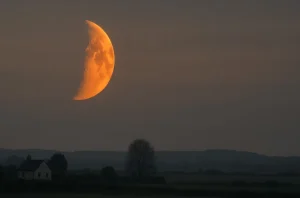Why does the Moon sometimes appear as a glowing orange disc in the sky? Is it a rare astronomical event, or just a trick of the atmosphere?
These questions often arise when observers notice the Moon displaying a striking orange hue, particularly during moonrise or moonset. While it may look extraordinary, this phenomenon has a very real and scientific explanation. The reason lies not in the Moon itself, but in the way its light passes through the Earth’s atmosphere.
The Moon turns orange due to atmospheric scattering, a process similar to what gives sunsets and sunrises their vivid colours.
This blog explores the scientific, environmental, and observational reasons behind the Moon’s orange appearance, using relatable examples and UK-specific context.
What causes the Moon to appear orange near the horizon?

The most common time to observe an orange Moon is during moonrise or moonset. When the Moon is close to the horizon, its light must travel through a much greater thickness of the Earth’s atmosphere compared to when it is higher in the sky.
This extended path through the atmosphere means that more light is scattered before it reaches your eyes.
The Earth’s atmosphere is filled with particles like oxygen, nitrogen, dust, and water vapour. These particles scatter shorter wavelengths of light, such as blue and violet, more than longer wavelengths like red and orange. This process is known as Rayleigh scattering.
As a result, the blue and violet light is filtered out, and only the longer redder wavelengths are left, making the Moon appear orange. It’s the same reason why the Sun looks red or orange when it sets.
This orange appearance is purely an optical effect. The Moon itself doesn’t change colour it only appears different because of the way its reflected sunlight is altered as it travels through the atmosphere.
How does atmospheric scattering affect the Moon’s colour?
The principle behind atmospheric scattering is grounded in physics. Rayleigh scattering describes how light interacts with molecules and small particles in the atmosphere.
It’s a process that favours the scattering of short-wavelength light (blue, violet), and allows long-wavelength light (red, orange) to pass through more easily.
When you see the Moon high in the sky, its light travels a shorter path through the atmosphere, so very little scattering occurs.
The Moon appears white or pale grey under these conditions. But as the Moon sinks closer to the horizon, the light path increases, and the amount of scattering rises dramatically.
This process removes much of the cooler blue tones and leaves behind the warmer hues. It’s also why the Moon may look golden, amber, or deep orange depending on specific atmospheric conditions.
The thickness of the atmosphere the light travels through can vary depending on your location, altitude, and weather. This means that the same Moon can look different to people in different areas or at different times of the year.
Can environmental conditions like dust and pollution make the Moon more orange?

Yes, and in some cases, these factors can make the Moon appear not just orange but a deep red or coppery colour.
Dust, smoke, haze, or pollution particles in the atmosphere increase the amount of scattering and absorption of blue light. When the air contains more particulates, such as after a wildfire or a major dust storm, the effect becomes more pronounced.
For example, when smoke from wildfires in southern Europe or North Africa drifts over the UK, it can significantly affect the quality of light in the sky. In such cases, observers may notice the Moon taking on an unusually rich hue.
Likewise, urban pollution, especially in densely populated areas like London or Birmingham, can alter the Moon’s appearance by increasing the number of scattering particles in the atmosphere.
Even moisture content, such as fog or high humidity, can contribute to a similar effect. These conditions act like a natural filter, allowing only the warmest light to pass through. This is why the Moon often appears more colourful in autumn and winter, when the UK tends to experience more mist and atmospheric moisture.
Why does the Moon turn orange or red during a lunar eclipse?
A lunar eclipse occurs when the Earth comes between the Sun and the Moon, casting a shadow that blocks direct sunlight from reaching the lunar surface. But during a total lunar eclipse, the Moon doesn’t disappear completely instead, it often turns a deep orange or red.
This is because some sunlight still reaches the Moon, but only after passing through Earth’s atmosphere. As this light is bent around the Earth, it gets filtered, and much like during moonrise or sunset, the blue light is scattered out, and red and orange light is directed onto the Moon’s surface.
This filtering effect is why the Moon appears red during an eclipse, earning the term “blood moon”. The intensity of the colour depends on the amount of dust, pollution, or volcanic ash in the atmosphere at the time.
For example, after major volcanic eruptions, lunar eclipses tend to be darker and more reddish due to the increased scattering of sunlight.
Is an orange Moon a common sight in the UK?
It is more common than many people realise. The UK’s temperate climate and atmospheric variability mean that conditions for observing an orange Moon occur regularly. In particular, orange Moons are frequently visible during:
- Moonrise and moonset times throughout the year
- Autumn and winter months, when humidity and haze levels are higher
- Full Moon events, especially around the time of the Harvest Moon
The Harvest Moon, which is the full Moon closest to the autumn equinox, is known for its orange glow. This Moon rises shortly after sunset and stays low on the horizon for longer, making it appear larger and warmer in colour.
It’s not just a rural observation even in urban areas with significant light pollution, the orange hue of the Moon can still be clearly visible under the right conditions.
What is the difference between an orange Moon and a red Moon?
While both appear due to atmospheric effects, they are triggered by different mechanisms. An orange Moon is generally the result of the Moon being low in the sky, passing through a thick layer of the atmosphere under specific weather or pollution conditions.
A red Moon, on the other hand, often refers to a total lunar eclipse, when the Earth’s shadow covers the Moon and only red-filtered light reaches it.
Here’s a comparative breakdown:
| Feature | Orange Moon | Red Moon (Lunar Eclipse) |
| Cause | Atmospheric scattering near horizon | Earth’s shadow during total lunar eclipse |
| Frequency | Very common | Relatively rare |
| Visibility | Often visible during moonrise or moonset | Only during full lunar eclipses |
| Colour Intensity | Ranges from yellow to deep orange | Ranges from copper red to deep blood red |
| Requires Specific Conditions | No (occurs regularly) | Yes (alignment of Earth, Sun, and Moon) |
Can the Moon appear orange during any phase?

The Moon can appear orange during any phase, though it’s most commonly observed during a full Moon due to its brightness and visibility near the horizon.
When the Moon is in a waxing gibbous, waning gibbous, or even a crescent phase, it can still exhibit an orange colour if the viewing conditions are right.
However, the visual impact may be less dramatic because these phases show only a portion of the Moon’s surface. The phenomenon is not dependent on the Moon’s phase, but rather on its position in the sky and the state of the atmosphere.
When is the best time to observe an orange Moon in the UK?
While orange Moons can appear at any time of year, certain periods provide ideal viewing opportunities in the UK. The best times are:
- Evenings around moonrise, especially when the Moon is full or nearly full
- Autumn months, particularly during the Harvest Moon and Hunter’s Moon
- After rainfall, when the air contains more particles and moisture
- Following dust storms or periods of poor air quality
Locations with a clear, unobstructed view of the horizon such as coastal regions or elevated rural areas, often offer the best vantage points. Check lunar calendars and local moonrise times to plan your observations.
Key Factors Behind the Orange Appearance of the Moon
| Factor | Impact on Moon’s Colour |
| Low position in sky (horizon) | Increases atmospheric scattering, leading to orange hues |
| High moisture or fog | Filters light, enhancing warm colours |
| Air pollution or dust | Scatters blue light, allowing orange/red wavelengths through |
| Wildfires or volcanic ash | Deepens the orange/red colour by increasing particulate density |
| Total lunar eclipse | Bends and filters light around Earth, causing red/orange glow |
Conclusion: Why does the Moon sometimes glow orange?
The Moon’s orange hue is not an unusual celestial event, but a natural consequence of how light interacts with the Earth’s atmosphere.
Whether it’s rising above the horizon or passing through a polluted or humid sky, the Moon’s light is scattered in such a way that orange and red wavelengths become dominant.
This effect, governed by the principles of Rayleigh scattering, turns our everyday Moon into a fiery disc that can inspire awe, curiosity, and sometimes myths.
Understanding the science behind this common yet fascinating phenomenon offers a deeper appreciation for what we see in the sky turning every moonrise into an opportunity for observation and wonder.
Frequently Asked Questions
What makes the Moon orange only at certain times?
The Moon appears orange when it’s low on the horizon, typically at moonrise or moonset. This is when its light travels through more of Earth’s atmosphere, increasing scattering.
Can weather conditions make the Moon appear more colourful?
Yes, conditions like humidity, fog, and air pollution can enhance the scattering effect, making the Moon appear more orange or red.
Does an orange Moon indicate a lunar eclipse?
Not necessarily. An orange Moon is usually caused by atmospheric scattering. A red Moon occurs during a total lunar eclipse, which is a different event.
Why is the Moon white at some times and orange at others?
When the Moon is high in the sky, its light travels a shorter path through the atmosphere, so less scattering occurs, and it appears white. When it’s near the horizon, scattering increases, and it appears orange.
Is it safe to look at an orange Moon?
Yes. Unlike solar observations, looking at the Moon orange or not is completely safe and poses no risk to your eyes.
Are there specific UK locations best for observing the orange Moon?
Coastal areas, open countryside, or elevated spots with clear views of the horizon offer ideal conditions for observing an orange Moon in the UK.
How often can we see an orange Moon in the UK?
Quite frequently, especially during full Moons, seasonal changes, and in conditions with high atmospheric moisture or pollution.
READ NEXT:






